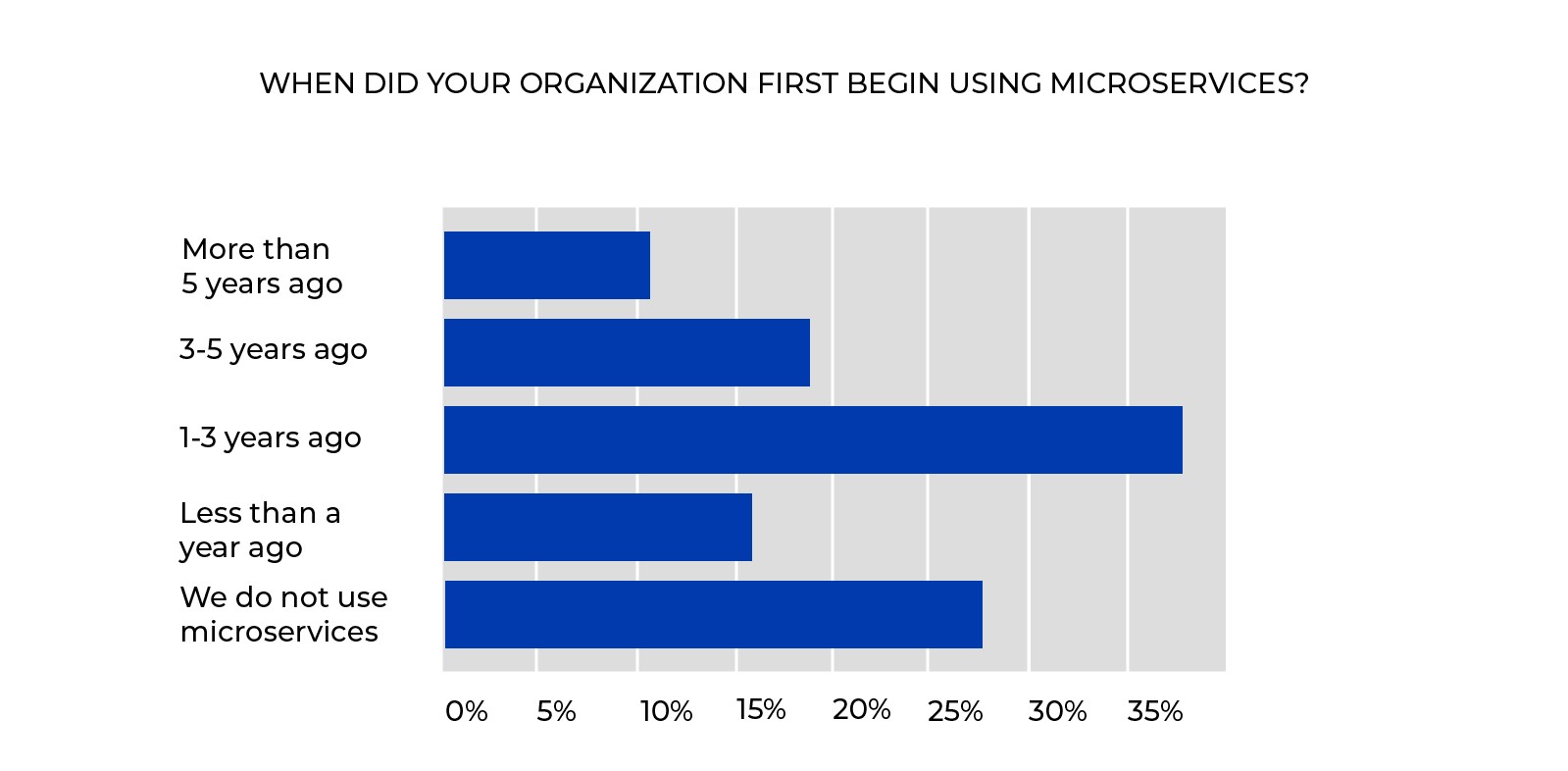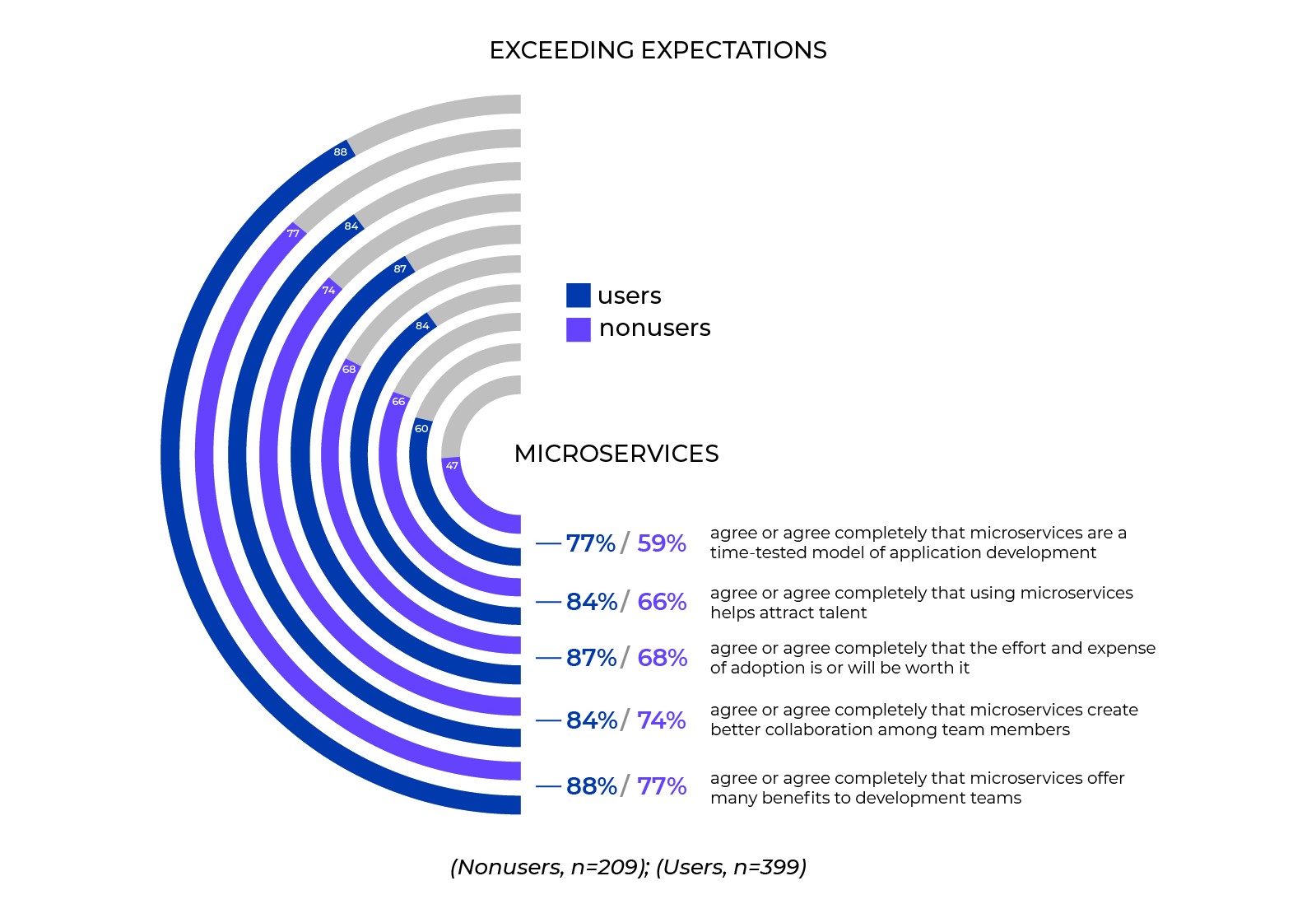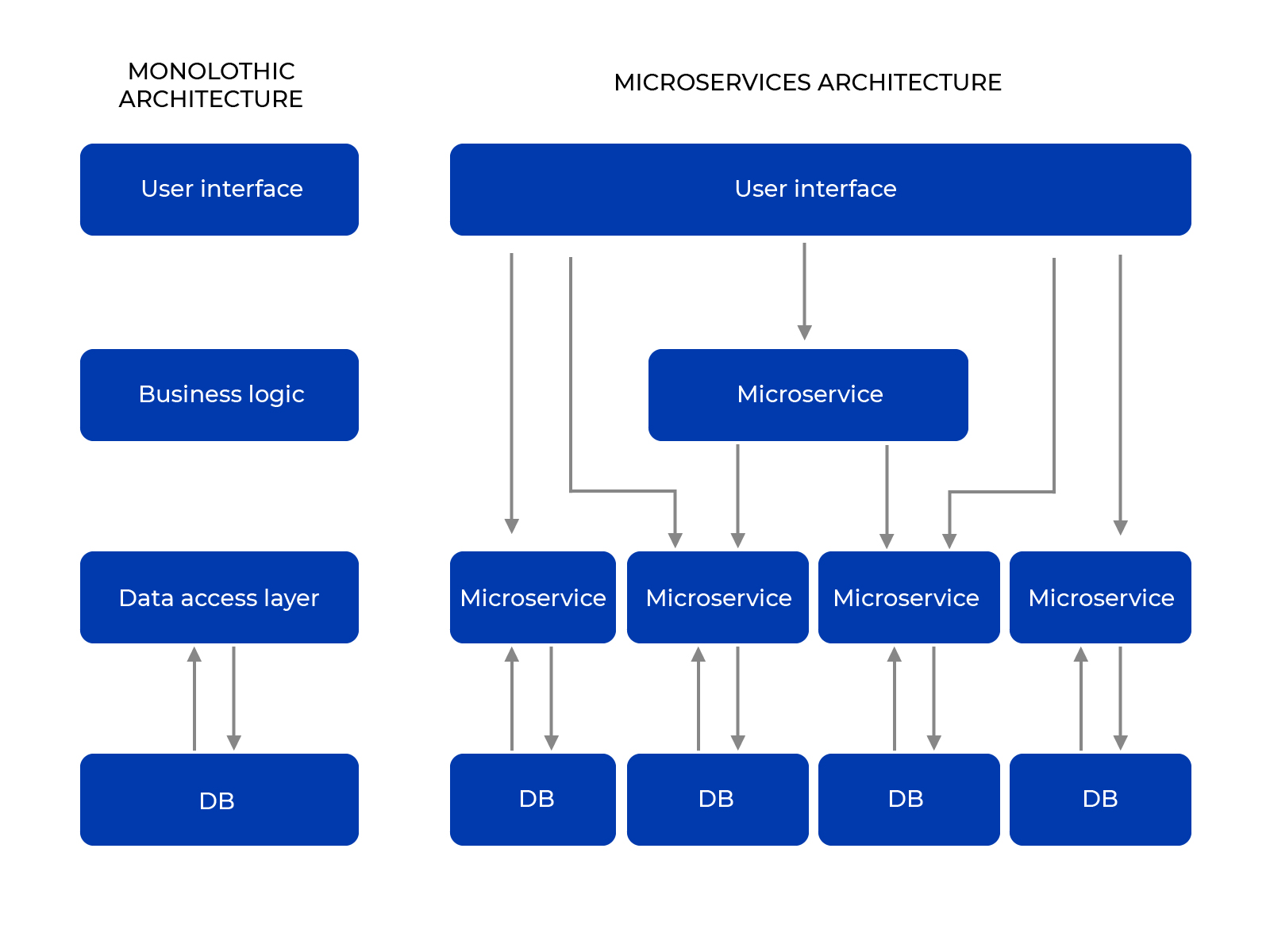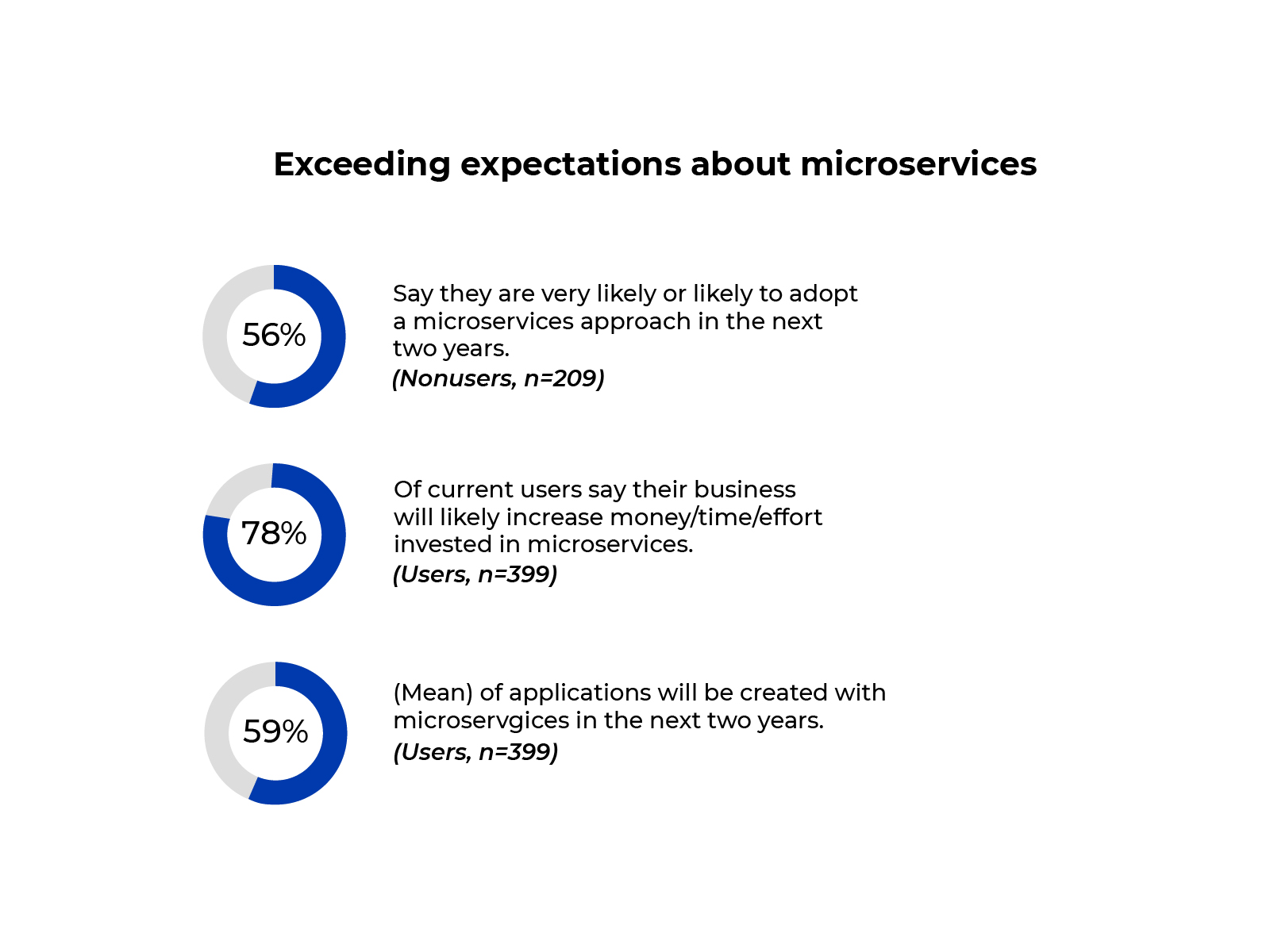
Top 10 Advantages of Microservices
According to data from a recent survey from Vanson Bourne, almost all the surveyed organizations are already taking advantage of the benefits of microservices.
This article focuses on the advantages of microservices and how they can help organizations achieve their goals as they are gaining popularity.
We'll also provide a brief definition of this technology stack so that newcomers can easily understand it.
What is Microservices Architecture ?
Due to the increasing popularity of microservices, it has become an integral part of the software development process. It enables organizations to create and manage their own microservices-based solutions, achieving more processing power.
Developers are now more focused on the dynamic and agile capabilities of microservices-based applications as they support greater application security for manual processes. 
Source: https://www.oreilly.com/radar/microservices-adoption-in-2020/
Microservices are the ultimate way to break up your application into smaller, more logically themed pieces.
Advantages of Microservices
The benefits of microservices architecture are so indisputable that some of the biggest enterprises, such as Amazon, eBay, and Netflix, have made considerable efforts to adopt the new technologies.
Compared to monolithic applications and designs, microservices architecture offers a more agile and adaptable approach that supports advanced business capabilities. The entire system of monolithic application is built as a single unified unit.
The most frequently quoted benefits of a microservices' architecture are:
Better fault isolation
Organizations can run large-scale applications managed independently without them being affected by the failure of a single module. Microservices compartmentalize processes, systems, and operations to ensure they can all function independently and simultaneously, thus preventing service outages.
Eliminate vendor or technology lock-in
Ease of understanding
Running and managing microservices allows development teams to better understand the functionality of a service. As a result, organizations can manage multiple services operated by distributed teams.
Easier and faster deployments
Microservices allow organizations to run processes faster than traditional methods with great cost savings. With a smaller and faster deployment, organizations can start to explore the benefits of continuous deployment across their entire system.

Source: IBM Market Development & Insights Report
Improved Scalability
The monolithic architectures are a traditional architecture of a software program, which is built as a unified unit that is self-contained and independent of other software applications. But Microservices have the ability to run faster than traditional methods in monolithic architectures.
With a small and fast deployment, organizations can start to explore the benefits of continuous deployment via event-driven microservices. They can also easily add, remove, and scale individual services without disrupting the other components of the application.
Programming Language and Technology Agnostic
Microservices have the competence to connect to various programming languages and platforms. This allows developers to create applications that run on any type of operating system, as well as independent services. This allows them to work with a wide variety of technologies and languages.
.jpg)
The number of users that utilize microservices within their organization.
Better Data Security and Compliance
Most developers use secure APIs to connect microservices. This allows them to safeguard the data by making sure it's only accessible to specifically authorized applications, users, and servers.
Greater Business Agility and Support for DevOps
Microservices support the DevOps mindset. In the era of digital transformation, businesses can rapidly develop and deploy new features and see user feedback in real time. This promotes collaboration among users, developers, and engineers, thus boosting user retention and satisfaction.
Continuous Integration/ Continuous Delivery (CI/CD)
Cost-effective architecture for deploying enterprise applications
With a cost-effective architecture, microservices can help organizations scale their applications as needed and enhance business functionality. They can also reduce the resources required to run them during peak hours. Having the right cloud orchestration tool can help manage the various aspects of the application.
Disadvantages of Microservices

Communication between services is complex
One of the biggest challenges that developers face when it comes to communication between services is the complexity of handling requests between them. In one instance, they may have to write additional code to avoid disrupting the operations of the other services.
More services equal more resources
Management of multiple databases and transactions can be cumbersome and costly.
Global testing is difficult
In terms of global testing, it can be hard to test a microservices-based application since it requires a lot of work to ensure that the various components are connected to the underlying database.
Debugging problems can be harder
Each service has its own set of logs to monitor, which takes a lot of time. So, for your development teams, this can be a pitfall.
Slower development
Another challenge that developers face when it comes to implementing a microservices-based application is the complexity of coordinating the various services.
Higher upfront costs
Microservices can be too complex and expensive for small and medium-sized businesses. Such companies have limited resources and the continuous delivery of software applications needs to be optimized so they can quickly build and maintain their tech stack. Microservices solutions support the modular architectural style they need to accomplish that.
How to Move Forward with Microservices
A common way to implement a microservices-based application is through containers. These virtual operating systems are designed to provide a complete environment that's isolated from the rest of the system.
One of the most prominent companies working on developing containers is Docker.
Amazon Web Services, for instance, can be beneficial when it comes to implementing a microservices-based solution.
However, since their virtual machines are generally more compact, they can potentially reduce the cost-effectiveness of the package.
Another way to implement a microservices-based solution is through an Open Service Gateway Initiative bundle. This method allows developers to run all of their services on a single virtual machine.

The lifecycle layer’s typical architecture
The increasing number of applications being developed today is fueling the debate about whether using a traditional software architecture or a microservices-based solution will only get more intense.
Developers should thoroughly research the various advantages and disadvantages of each approach before making a final decision.
Small and medium-sized businesses can start with a single monolithic solution and quickly move to a more flexible and cost-effective approach with the use of microservices.
Large organizations, on the other hand, are usually the ideal candidates when it comes to implementing a microservices-based solution due to their need for scalability and uptime.
Examples of Microservices in Action
Amazon
In 2001, Amazon faced issues with its growing customer base and the complexity of its monolithic applications. To address these issues, the company shifted its focus to developing small and independent applications.
Before implementing a microservices-based solution, developers had to analyze the source code and pull out units of code that serve a single purpose. Through Amazon's service-oriented architecture, teams were able to focus on one service instead of the other.
This method allowed them to quickly resolve various issues and improve the efficiency of their work.
Netflix
Netflix started its journey toward a microservices-based solution in 2008. During this time, the company experienced various issues related to its movie-streaming service. For three days, it was unable to deliver DVDs to its members.
In 2009, Netflix started the process of converting its existing monolithic architecture to microservices.
The company migrated its non-core movie-coding platform to Amazon Web Services as an independent microservice architecture. It took two years for the conversion to be completed.
Uber
Following the launch of its app, Uber faced various issues related to its monolithic architecture.
These included the lack of agility and the ability to launch new features. The platform also had to deal with bugs and other issues related to its rapid global expansion.
Due to the complexity of its existing architecture, Uber had to constantly update its system to keep up with the changes. To address these issues, the company broke its traditional approach into cloud-based microservices.
Developers then started building individual microservices for various functions, such as trip management and passenger management. Through Amazon's API Gateway, Uber was able to connect its microservices to its platform.
Conclusion
Before implementing a new strategy, organizations should consider the potential return on investment. The path to implementing a new system is dependent on the project's specific requirements. You should compare all the advantages and disadvantages of microservices.
At InventorSoft, our developers can help you to implement microservices based on your project requirements.
Related articles

Top 10 Essential Functional Requirements for Warehouse Management Systems

10 Relevant Steps to Create Your Online Learning Platform

How to build a minimum viable product for your startup
- Advantages of Microservices
- Disadvantages of Microservices
- How to Move Forward with Microservices
- Examples of Microservices in Action
- Conclusion




